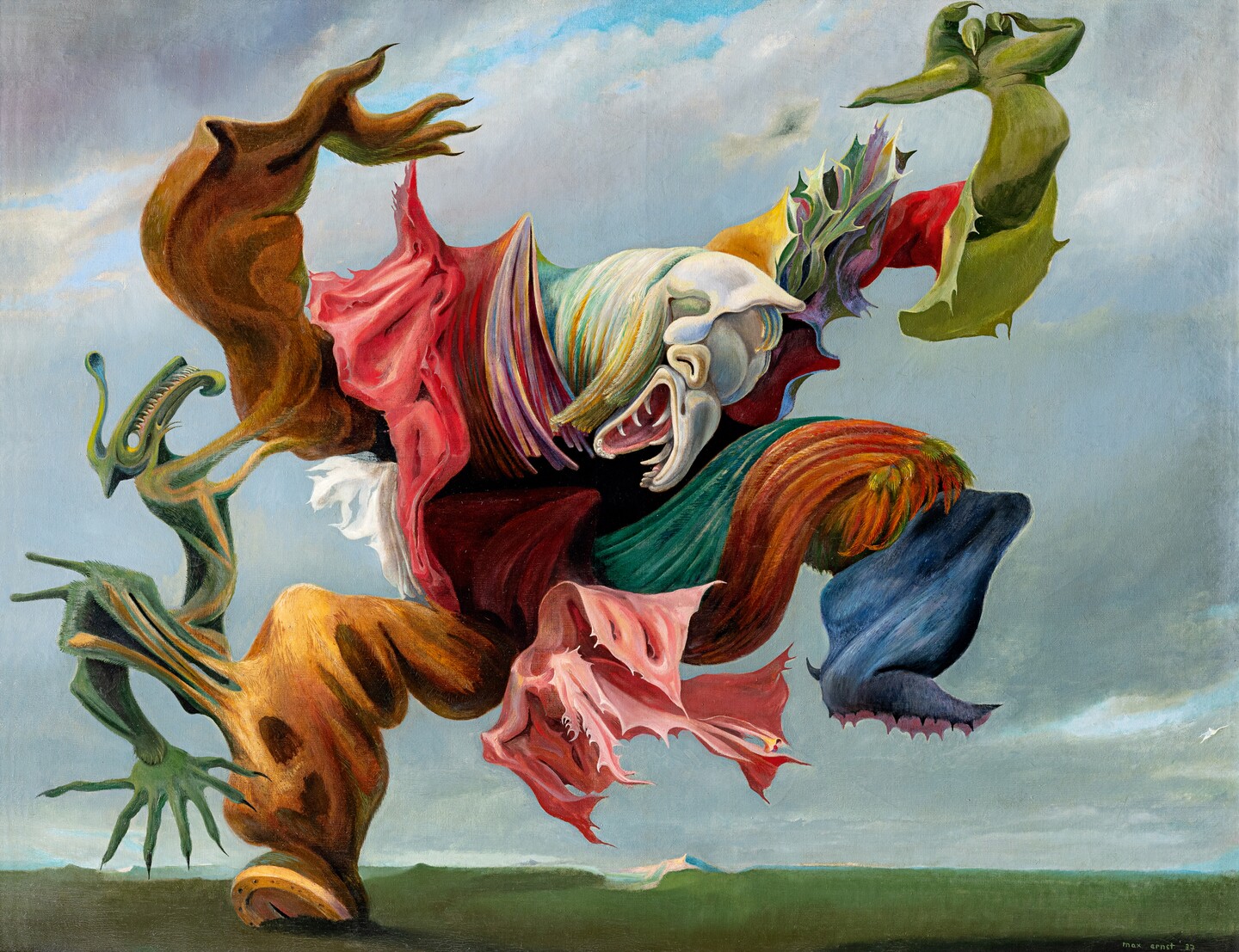RENDEZVOUS OF DREAMS
Press information
Surrealism and German Romanticism
Curator
Dr. Annabelle Görgen-Lammers
Assistant Curators
Vera Bornkessel (since Oct 2024)
Maria Sitte (since Feb 2024)
Research Assistant
Laura Förster (Jan - Sep 2024)
Under the patronage of
François Delattre, French Ambassador to Germany
Dr. Peter Tschentscher, First Mayor and President of the Senate of Freie und Hansestadt Hamburg
Press Conference
Thursday, 12 Juni 2025, 11 am
Eröffnung
Thursday, 12 Juni 2025, 7 pm
The major exhibition RENDEZVOUS OF DREAMS at the Hamburger Kunsthalle commemorates the 100th anniversary of the founding of international Surrealism by examining its striking affinities with German Romanticism. Taking as its starting point a novel comparison of two paintings in the Kunsthalle, the show places over 230 iconic works by both great and lesser-known Surrealists – among them Max Ernst, Meret Oppenheim, René Magritte, André Masson, Salvador Dalí, Dorothea Tanning, Paul Klee, Valentine Hugo, Victor Brauner and Toyen – in new contexts as well as stimulating juxtapositions with more than 70 masterpieces of German Romanticism, including works by Caspar David Friedrich and Philipp Otto Runge alongside examples of Romantic poetry.
Themes that fascinated German Romantic artists and writers, such as the night and dreams – understood as a kind of higher vision – as well as the power of imagination, the microcosm versus the macrocosm, and a special feeling for nature would serve as sources of inspiration for Surrealism one century later. The intellectual attitudes and pictorial inventions of Friedrich, Runge, Carl Gustav Carus, Carl Wilhelm Kolbe and many more, along with the writings of Novalis, Achim and Bettine v. Arnim, Karoline v. Günderrode, Johann Wolfgang v. Goethe, Friedrich Hölderlin and Heinrich von Kleist, would play an important role in the search for a revolutionary form of art in the twentieth century. Astoundingly, this recourse to Romanticism was even more pronounced in the years of war, resistance and exile, when Surrealism took up the mantle of the earlier movement as a reaction against the »disenchantment of the world«, reflecting its revolutionary dimension. Both movements focused on evoking a certain attitude toward life and calling into question assumptions about reality and its limitations – culminating in nothing less than a transformation of individual and society. Though born out of a different historical situation, Novalis’s credo of the »romanticisation of the world« seems to anticipate the Surrealists’ striving for a higher spiritual revolt in the form of a »surreality«.
- Read more
When the two movements are considered together based on intriguing comparisons as well as explicit tributes, in some cases involving works selected from the Kunsthalle’s own collection, certain analogies and differences become manifest. One example is Max Ernst’s painting A Beautiful Morning (Un beau matin), an homage to Morning (first version) (1808) by Philipp Otto Runge. Produced after his first visit to the Hamburger Kunsthalle in 1965, Ernst’s painting makes reference both conceptually and formally to his revered Romantic colleague. The two important works have been in the Kunsthalle’s collection for more than 60 years but are now being analysed and presented together for the very first time. New research has also brought to light another surprising Hamburg reception history, in this case for Max Ernst’s programmatic Surrealist painting The Rendezvous of Friends (1922).
In another section of the exhibition, Julian Rosefeldt’s contemporary video Manifesto (2015) highlights the enduring relevance of the question André Breton posed 100 years ago in his Surrealist manifesto regarding the importance of imagination, dreaming and the exploration of other levels of reality. RENDEZVOUS OF DREAMS thus brings together specific local as well as far-flung international discoveries spanning
different media and periods.For this large-scale exhibition, the Hamburger Kunsthalle is collaborating for the first time with the Centre Pompidou, Musée national d’Art Moderne, Paris, enabling it to present over 30 exceptional works on loan including Salvador Dalí’s The Invisible Sleeping Woman, Horse, Lion etc. (1930) and René Magritte’s The Double Secret (1927). In its entirety, the comprehensive exhibition offers visitors the unique opportunity to experience world-renowned artworks, some of them never before shown, from over 80 international, private and public collections in the USA, Mexico and several European countries, including the Philadel-phia Museum of Art; the Museum of Modern Art, New York; the Colección FEMSA (Mexico); the Centre Pompidou in Paris; the Tate London; the Kunsthalle Prague; the Kunsthaus Zürich and many more, as well as more than 30 international private collections, some of which have remained hidden until now.
The works on display date from the late eighteenth century to 1980 and cover all media, comprising around 300 paintings, prints, drawings, photographs, films, sculptures and objects by 65 Surrealists and 30 Romantic artists. Among them are many still under-recognised Surrealists such as Meret Oppenheim, Dorothea Tanning, Remedios Varo, Suzanne Van Damme and Jane Graverol. A large number of archival documents and manuscripts in the show trace the reception of the German Romantics by the Surrealists.
In 15 chapters, including Friendship, Dream, Metamorphoses, Perception of Nature, Love, Ruin, Forest, Cosmos and Hymns to the Night, the extensive exhibition compares and contrasts themes, philosophical concepts, paradigms, motifs and methods in visual art, poetry and theory, beginning with a consideration of the Manifesto of Surrealism by André Breton and explicit homages by the Surrealists to the German Romantics.
RENDEZVOUS OF DREAMS comprises three exhibition areas and extends over a total of 2,000 square metres, from the Hubertus Wald Forum (1/Dream), via a »Passage« consisting of several cabinets providing background information, to the gallery before the Rotunda in the Lichtwark building (2/Forest) and finally the stately domed hall (3/Cosmos).
In the »Passage« between the sections, the Kunsthalle’s Art Education and Outreach department has devised interactive activities that allow viewers to draw inspiration from the original works to try out various artistic techniques, Surrealist processes and games. In addition to a photo station and the Surrealist game Cadavre Exquis, Romantic and Surrealist literature enables visitors to immerse themselves in the artists’ world. Another station offers sylvan sounds and scents that attune visitors to the exhibition section 2/Forest.
A wide range of guided tours for the public or for private booking provide in-depth information on the exhibits, as do the audio tours for adults (German/English) and for children and young people aged 8 and over (German), which are available free of charge via the Kunsthalle app. On one Saturday a month, various artistic techniques can be tried out at the Open Studio for the whole family.The comprehensive event programme offers expert and artist talks as well as panel discussions at the Hamburger Kunsthalle and the Abaton Cinema, which will be screening a number of Surrealist films to accompany the exhibition. For example, the internationally renowned artist Julian Rosefeldt will speak about the background behind his work Manifesto in the show and the power of Surrealism (4 Sept.). The Salon Surreal (18 Sept.) will musically spotlight current topics relating to the exhibition and host some interesting guests. And the young friends’ society, Junge Freunde der Kunsthalle e. V., is organising a big party to round out the show (3 July).
An extensive, richly illustrated catalogue (344 pages, Hatje Cantz Verlag) is available for 45 euros at the museum store or via www.freunde-der-kunsthalle.de at the bookstore price of 58 euros. Over 30 international scholars of Surrealism present here the latest findings on the relationship between international Surrealism and German Romanticism, organised according to the chapters of the exhibition and with a focus on individual protagonists.
The exhibition is part of the international celebration marking the 100th anniversary of the Manifesto of Surrealism and is being hosted in varying forms at the Musées royaux des Beaux-Arts de Belgique, Brussels (21 February to 21 July 2024), the Centre Georges Pompidou, Paris (4 September 2024 to 13 January 2025), the Fundación Mapfre, Madrid (6 February to 11 May 2025), and the Philadelphia Museum of Art (8 November 2025 to 16 February 2026).
Dr. Carsten Brosda, Hamburg Senator for Culture and Media: »Following the major exhibition marking the 250th anniversary of the birth of Caspar David Friedrich, the Hamburger Kunsthalle is now celebrating 100 years of Surrealism. In keeping with the collection’s focus on Romanticism, the exhibition explores for the first time the Surrealists’ fascination with the German Romantics and spotlights the extent to which artists reacted to social upheavals in their works. The cooperation with the Centre Pompidou and other renowned museums demonstrates what is possible when cultural institutions work together across borders. The Kunsthalle is thus once again creating a first-rate cultural occasion for residents of the city and a reason for visitors from all over to flock to Hamburg.«
Michael Behrendt, Chairman of the Hapag-Lloyd Foundation: »Surrealism, whose 100th anniversary we are celebrating with this exhibition, promoted values that are more important today than ever: questioning what is familiar, appreciating the power of the imagination and strengthening interpersonal dialogue. We therefore immediately agreed to act as the main sponsor for this marvellous retrospective as our contribution to the creative dynamism and cultural diversity of our ›home port‹ of Hamburg.«
Dr. Ekkehard Nümann, Chairman of the Freunde der Kunsthalle e. V.: »We are once again delighted to be able to provide significant support for such a trailblazing exhibition project. The origins of this show lie in a pair of paintings by Max Ernst and Philipp Otto Runge in the collection of the Hamburger Kunsthalle that have prompted a joint consideration of German Romanticism and international Surrealism. Comparing these two masterpieces has opened up new areas of research while offering art-lovers a fresh perspective on the two periods.«
Prof. Dr. Frank Druffner, Acting Secretary General of the Kulturstiftung der Länder: »With this exhibition, the Hamburger Kunsthalle is proposing a new approach to two important focal points of its collection by juxtaposing works of German Romanticism for the first time with the international Surrealist movement in order to trace intellectual affinities across time and national borders. I am particularly pleased that the achievements of female artists from both movements are also being honoured here – thanks to prestigious international loans – so that attention can be drawn to this gap in the history of art.«
The exhibition RENDEZVOUS OF DREAMS is under the patronage of the French Ambassador to Germany, François Delattre, and the First Mayor and President of the Senate of the Free and Hanseatic City of Hamburg, Dr. Peter Tschentscher.
Annette Kreidler, Marketing Director at Fürst Bismarck Quelle: »Varied offerings can help to promote cultural education across generations and societal barriers, and we are therefore delighted to be able to support this aim with the Fürst Bismarck brand for the third year in a row.«
Press release
In cooperation with

Main sponsor

Supported by








The art education programme for the exhibition was made possible by Fürst Bismarck Quelle.

Cultural partner

Media partner

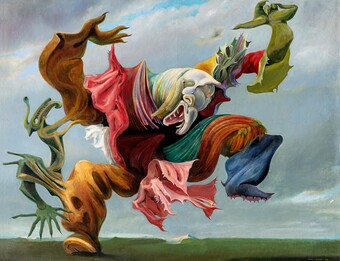
Der Hausengel (Der Triumph des Surrealismus) (L'ange du foyer (Le triomphe du surréalisme)), 1937
Öl auf Leinwand, 114,2 x 146,5 cm
Collection Hersaint Family
© VG Bild-Kunst, Bonn 2025
Foto: Vincent Everarts Photography Brussels
Diese Pressebilder stehen in druckfähiger Qualität im Online-Presseservice unter www.hamburger-kunsthalle.de zum Download bereit. © Veröffentlichung nur gestattet im Zusammenhang mit einer aktuellen redaktionellen Berichterstattung über die Ausstellung in der Hamburger Kunsthalle. Jede andere Nutzung ist nicht gestattet. Die Bilder dürfen nicht angeschnitten und/oder mit Schrift überschrieben werden. Hinweis zur VG Bild-Kunst: Eine kostenfreie Veröffentlichung ist nur im Rahmen der aktuellen Berichterstattung über die Ausstellung ab 3 Monaten vor Beginn und bis 6 Wochen nach Ende der Ausstellung gestattet. Für die Verwendung in Social Media-Kanälen bedarf es einer gesonderten Klärung mit der VG Bild-Kunst.
Publication only allowed in connection with editorial reports of the exhibition. Any other use is not allowed. The photos should not be cropped or overwritten
with any form of text. Note on VG Bild-Kunst: A free publication is only permitted within the scope of the reporting on the exhibition, from 3 months before the exhibition starts and until 6 weeks after the ending. For use in social media channels it requires a separate clarification with the VG Bild-Kunst.

Dahl: Museum Folkwang, Essen © akg-images.
1) Ernst: Bayerische Staatsgemäldesammlungen, München, Pinakothek der Moderne, 2013 als Schenkung der Theo Wormland-
Stiftung GmbH erworben© VG Bild-Kunst, Bonn 2025.
2) Ernst: Collection Hersaint © VG Bild-Kunst, Bonn 2025.
Füssli: Museum zu Allerheiligen Schaffhausen, Depositum der Sturzenegger-Stiftung, Inv. Nr. A1749 © Museum zu Allerheiligen
Schaffhausen.
Dalí: Centre Pompidou, Paris, Musée national d’art moderne / Centre de création industrielle © bpk | CNAC-MNAM
© Salvador Dalí, Fundació Gala-Salvador Dalí / Bild-Kunst, Bonn 2025.
Kersting: Hamburger Kunsthalle © Hamburger Kunsthalle / bpk.
Foto: © Hamburger Kunsthalle, Fred Dott
Diese Pressebilder stehen in druckfähiger Qualität im Online-Presseservice unter www.hamburger-kunsthalle.de zum Download bereit. © Veröffentlichung nur gestattet im Zusammenhang mit einer aktuellen redaktionellen Berichterstattung über die Ausstellung in der Hamburger Kunsthalle. Jede andere Nutzung ist nicht gestattet. Die Bilder dürfen nicht angeschnitten und/oder mit Schrift überschrieben werden.
Hinweis zur VG Bild-Kunst: Eine kostenfreie Veröffentlichung ist nur im Rahmen der aktuellen Berichterstattung über die Ausstellung ab 3 Monaten vor Beginn und bis 6 Wochen nach Ende der Ausstellung gestattet. Für die Verwendung in Social Media-Kanälen bedarf es einer gesonderten Klärung mit der VG Bild-Kunst.
Publication only allowed in connection with editorial reports of the exhibition. Any other use is not allowed.
The photos should not be cropped or overwritten with any form of text.
Note on VG Bild-Kunst: A free publication is only permitted within the scope of the reporting on the exhibition, from 3 months before the exhibition starts
and until 6 weeks after the ending. For use in social media channels it requires a separate clarification with the VG Bild-Kunst.
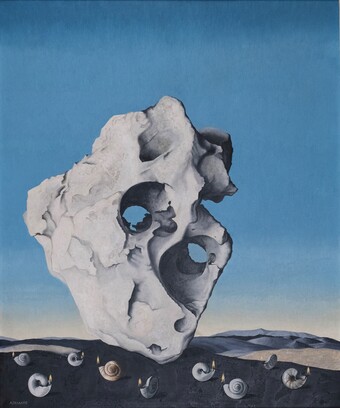
Eine Kerze des Verstehens in deinem Herzen (A Candle of Understanding in Thine Heart), 1964
Tempera auf Karton, 58,4 x 48,2 cm
RAW Collection
© 2025 Artist Estate courtesy of RAW
Diese Pressebilder stehen in druckfähiger Qualität im Online-Presseservice unter www.hamburger-kunsthalle.de zum Downloadbereit.
© Veröffentlichung nur gestattet im Zusammenhang mit einer aktuellen redaktionellen Berichterstattung über die Ausstellung in der Hamburger Kunsthalle. Jede andere Nutzung ist nicht gestattet. Die Bilder dürfen nicht angeschnitten und/oder mit Schrift überschrieben werden.
Publication only allowed in connection with editorial reports of the exhibition. Any other use is not allowed.
The photos should not be cropped or overwritten with any form of text.
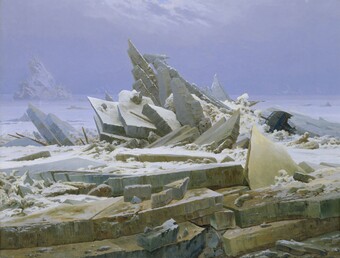
Das Eismeer, 1823/24
Öl auf Leinwand, 96,7 x 126,9 cm
Hamburger Kunsthalle
© Hamburger Kunsthalle / bpk
Foto: Elke Walford
Diese Pressebilder stehen in druckfähiger Qualität im Online-Presseservice unter www.hamburger-kunsthalle.de zum Downloadbereit.
© Veröffentlichung nur gestattet im Zusammenhang mit einer aktuellen redaktionellen Berichterstattung über die Ausstellung in der Hamburger Kunsthalle. Jede andere Nutzung ist nicht gestattet. Die Bilder dürfen nicht angeschnitten und/oder mit Schrift überschrieben werden.
Publication only allowed in connection with editorial reports of the exhibition. Any other use is not allowed.
The photos should not be cropped or overwritten with any form of text.
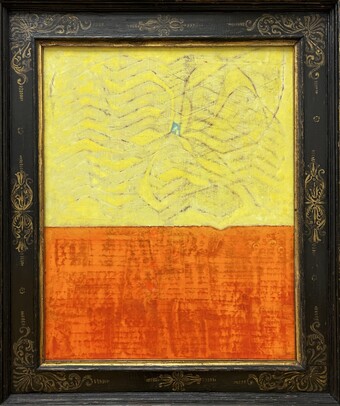
Ein schöner Morgen (Un beau
matin), 1965
Öl auf Leinwand, 92 x 73 cm
Hamburger Kunsthalle,
Dauerleihgabe der Stiftung
Hamburger Kunstsammlungen,
© Hamburger Kunsthalle / bpk
© VG Bild-Kunst, Bonn 2025
Foto: Elke Walford
Diese Pressebilder stehen in druckfähiger Qualität im Online-Presseservice unter www.hamburger-kunsthalle.de zum Download bereit. © Veröffentlichung nur gestattet im Zusammenhang mit einer aktuellen redaktionellen Berichterstattung über die Ausstellung in der Hamburger Kunsthalle. Jede andere Nutzung ist nicht gestattet. Die Bilder dürfen nicht angeschnitten und/oder mit Schrift überschrieben werden.
Hinweis zur VG Bild-Kunst: Eine kostenfreie Veröffentlichung ist nur im Rahmen der aktuellen Berichterstattung über die Ausstellung ab 3 Monaten vor Beginn und bis 6 Wochen nach Ende der Ausstellung gestattet. Für die Verwendung in Social Media-Kanälen bedarf es einer gesonderten Klärung mit der VG Bild-Kunst.
Publication only allowed in connection with editorial reports of the exhibition. Any other use is not allowed.
The photos should not be cropped or overwritten with any form of text.
Note on VG Bild-Kunst: A free publication is only permitted within the scope of the reporting on the exhibition, from 3 months before the exhibition starts and until 6 weeks after the ending. For use in social media channels it requires a separate clarification with the VG Bild-Kunst.
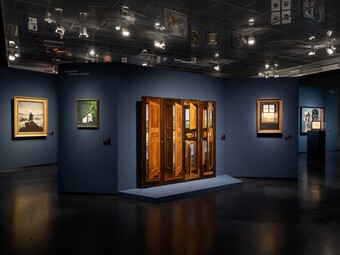
2025, v.l. mit den Werken Wanderer über dem Nebelmeer, um 1817, von Caspar David Friedrich, Zu einer bestimmten
Stunde, 1963, von Toyen, (Surrealistischer) Schrank, 1941, von Marcel Jean, Blick auf Schloß Pillnitz, 1823, von Johann Christian
Dahl und Das doppelte Geheimnis, 1927, von René Magritte
Friedrich: Hamburger Kunsthalle © Hamburger Kunsthalle / bpk.
Toyen: Privatsammlung, Courtesy Galerie 1900-2000, Paris © Courtesy Galerie 1900-2000, Paris © VG Bild-Kunst, Bonn 2025.
Jean: Paris, Musée des Arts Décoratifs © Les Arts Décoratifs © VG Bild-Kunst, Bonn 2025.
Dahl: Museum Folkwang, Essen © akg-images.
Magritte: Centre Pompidou, Paris, Musée national d’art moderne / Centre de création industrielle © bpk | CNAC-MNAM
© VG Bild-Kunst, Bonn 2025.
Foto: © Hamburger Kunsthalle, Fred Dott
Diese Pressebilder stehen in druckfähiger Qualität im Online-Presseservice unter www.hamburger-kunsthalle.de zum Download bereit. © Veröffentlichung nur gestattet im Zusammenhang mit einer aktuellen redaktionellen Berichterstattung über die Ausstellung in der Hamburger Kunsthalle. Jede andere Nutzung ist nicht gestattet. Die Bilder dürfen nicht angeschnitten und/oder mit Schrift überschrieben werden.
Hinweis zur VG Bild-Kunst: Eine kostenfreie Veröffentlichung ist nur im Rahmen der aktuellen Berichterstattung über die Ausstellung ab 3 Monaten vor Beginn und bis 6 Wochen nach Ende der Ausstellung gestattet. Für die Verwendung in Social Media-Kanälen bedarf es einer gesonderten Klärung mit der VG Bild-Kunst.
Publication only allowed in connection with editorial reports of the exhibition. Any other use is not allowed.
The photos should not be cropped or overwritten with any form of text.
Note on VG Bild-Kunst: A free publication is only permitted within the scope of the reporting on the exhibition, from 3 months before the exhibition starts
and until 6 weeks after the ending. For use in social media channels it requires a separate clarification with the VG Bild-Kunst.
![Victor Brauner (1903–1966) Porträt von André Breton (Portrait d'André Breton), 1934 Öl auf Leinwand, 61 x 50 cm Paris Musées / Musée d'Art moderne © bpk / Paris Musées / Musée d'Art moderne, Dist. GrandPalaisRmn / image ville de Paris © VG Bild-Kunst, Bonn 2025 [Nur auf Anfrage erhältlich] Victor Brauner (1903–1966) Porträt von André Breton (Portrait d'André Breton), 1934 Öl auf Leinwand, 61 x 50 cm Paris Musées / Musée d'Art moderne © bpk / Paris Musées / Musée d'Art moderne, Dist. GrandPalaisRmn / image ville de Paris © VG Bild-Kunst, Bonn 2025 [Nur auf Anfrage erhältlich]](/sites/default/files/styles/340_breit/public/2025-05/Brauner_Portrait_von_Andre_Breton_1934_klein_%20mit%20Balken.png?itok=804ovk1W)
Porträt von André Breton (Portrait
d'André Breton), 1934
Öl auf Leinwand, 61 x 50 cm
Paris Musées / Musée d'Art moderne
© bpk / Paris Musées / Musée d'Art
moderne, Dist. GrandPalaisRmn /
image ville de Paris
© VG Bild-Kunst, Bonn 2025
[Nur auf Anfrage erhältlich]
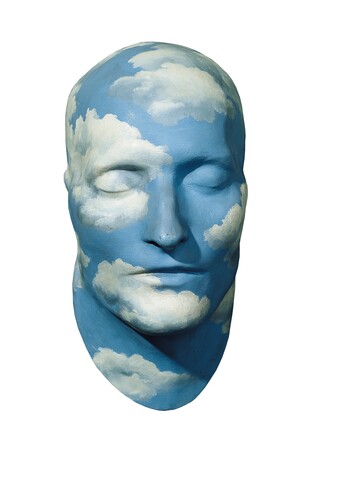
Die Zukunft der Statuen (L’avenir des statues), 1932
Öl auf Gipsguss (Totenmaske Napoleons), 33,5 x 16,5 x 19 cm
Lehmbruck Museum, Duisburg
© Lehmbruck Museum, Duisburg /
© VG Bild-Kunst, Bonn 2025
Foto: Bernd Kirtz
Diese Pressebilder stehen in druckfähiger Qualität im Online-Presseservice unter www.hamburger-kunsthalle.de zum Download bereit. © Veröffentlichung nur gestattet im Zusammenhang mit einer aktuellen redaktionellen Berichterstattung über die Ausstellung in der Hamburger Kunsthalle. Jede andere Nutzung ist nicht gestattet. Die Bilder dürfen nicht angeschnitten und/oder mit Schrift überschrieben werden.
Hinweis zur VG Bild-Kunst: Eine kostenfreie Veröffentlichung ist nur im Rahmen der aktuellen Berichterstattung über die Ausstellung ab 3 Monaten vor Beginn und bis 6 Wochen nach Ende der Ausstellung gestattet. Für die Verwendung in Social Media-Kanälen bedarf es einer gesonderten Klärung mit der VG Bild-Kunst.
Publication only allowed in connection with editorial reports of the exhibition. Any other use is not allowed.
The photos should not be cropped or overwritten with any form of text.
Note on VG Bild-Kunst: A free publication is only permitted within the scope of the reporting on the exhibition, from 3 months before the exhibition starts and until 6 weeks after the ending. For use in social media channels it requires a separate clarification with the VG Bild-Kunst.
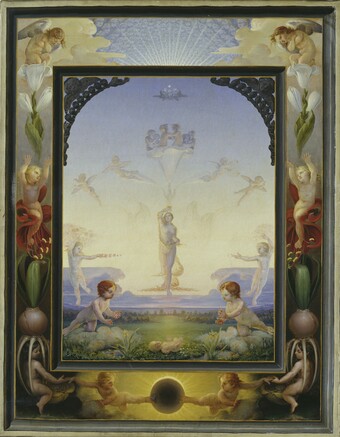
Der Morgen (erste Fassung), 1808
Öl auf Leinwand
109 cm x 85, 5cm
Hamburger Kunsthalle / bpk
Foto: Elke Walford
Diese Pressebilder stehen in druckfähiger Qualität im Online-Presseservice unter www.hamburger-kunsthalle.de zum Downloadbereit.
© Veröffentlichung nur gestattet im Zusammenhang mit einer aktuellen redaktionellen Berichterstattung über die Ausstellung in der Hamburger Kunsthalle. Jede andere Nutzung ist nicht gestattet. Die Bilder dürfen nicht angeschnitten und/oder mit Schrift überschrieben werden.
Publication only allowed in connection with editorial reports of the exhibition. Any other use is not allowed.
The photos should not be cropped or overwritten with any form of text.
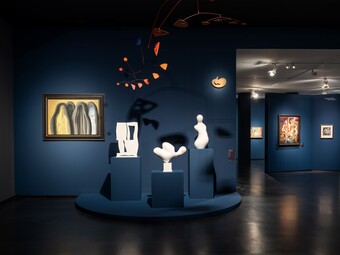
Magritte: Hamburger Kunsthalle © SHK / Hamburger Kunsthalle / bpk © VG Bild-Kunst, Bonn 2025.
Alle Arp-Skulpturen und das Mobile von Calder: Hamburger Kunsthalle © Hamburger Kunsthalle / bpk © VG Bild-Kunst, Bonn 2025.
Arp (Relief): Sammlung Ulla und Heiner Pietzsch, Berlin.
1) Masson: Collection Simone Collinet © Centre Pompidou-Metz.
2) Masson: Privatsammlung © Courtesy Privatsammlung.
Foto: © Hamburger Kunsthalle, Fred Dott
Diese Pressebilder stehen in druckfähiger Qualität im Online-Presseservice unter www.hamburger-kunsthalle.de zum Download bereit. © Veröffentlichung nur gestattet im Zusammenhang mit einer aktuellen redaktionellen Berichterstattung über die Ausstellung in der Hamburger Kunsthalle. Jede andere Nutzung ist nicht gestattet. Die Bilder dürfen nicht angeschnitten und/oder mit Schrift überschrieben werden.
Hinweis zur VG Bild-Kunst: Eine kostenfreie Veröffentlichung ist nur im Rahmen der aktuellen Berichterstattung über die Ausstellung ab 3 Monaten vor Beginn und bis 6 Wochen nach Ende der Ausstellung gestattet. Für die Verwendung in Social Media-Kanälen bedarf es einer gesonderten Klärung mit der VG Bild-Kunst.
Publication only allowed in connection with editorial reports of the exhibition. Any other use is not allowed.
The photos should not be cropped or overwritten with any form of text.
Note on VG Bild-Kunst: A free publication is only permitted within the scope of the reporting on the exhibition, from 3 months before the exhibition starts and until 6 weeks after the ending. For use in social media channels it requires a separate clarification with the VG Bild-Kunst.
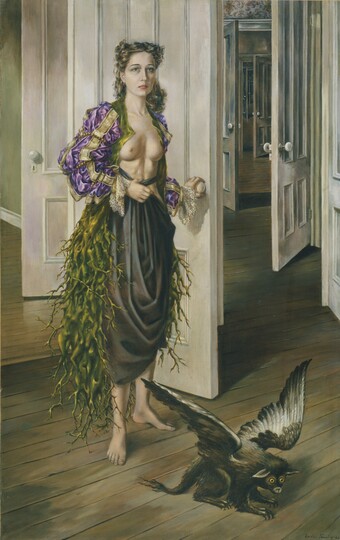
Geburtstag (Birthday), 1942
Öl auf Leinwand, 102,2 x 64,8 cm
Philadelphia Museum of Art: 125th Anniversary Acquisition. Purchased with funds contributed by C.K. Williams, II, 1999
© Courtesy of the Philadelphia Museum of Art
© VG Bild-Kunst, Bonn 2025
Diese Pressebilder stehen in druckfähiger Qualität im Online-Presseservice unter www.hamburger-kunsthalle.de zum Download bereit. © Veröffentlichung nur gestattet im Zusammenhang mit einer aktuellen redaktionellen Berichterstattung über die Ausstellung in der Hamburger Kunsthalle. Jede andere Nutzung ist nicht gestattet. Die Bilder dürfen nicht angeschnitten und/oder mit Schrift überschrieben werden.
Hinweis zur VG Bild-Kunst: Eine kostenfreie Veröffentlichung ist nur im Rahmen der aktuellen Berichterstattung über die Ausstellung ab 3 Monaten vor Beginn und bis 6 Wochen nach Ende der Ausstellung gestattet. Für die Verwendung in Social Media-Kanälen bedarf es einer gesonderten Klärung mit der VG Bild-Kunst.
Publication only allowed in connection with editorial reports of the exhibition. Any other use is not allowed.
The photos should not be cropped or overwritten with any form of text.
Note on VG Bild-Kunst: A free publication is only permitted within the scope of the reporting on the exhibition, from 3 months before the exhibition starts and until 6 weeks after the ending. For use in social media channels it requires a separate clarification with the VG Bild-Kunst.
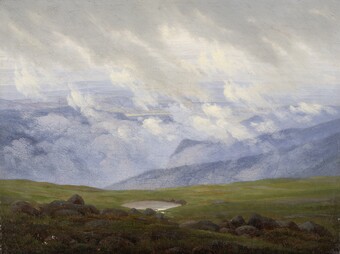
Ziehende Wolken, um 1820
Öl auf Leinwand, 18,3 x 24,5 cm
Hamburger Kunsthalle
© Hamburger Kunsthalle / bpk
Foto: Elke Walford
Diese Pressebilder stehen in druckfähiger Qualität im Online-Presseservice unter www.hamburger-kunsthalle.de zum Downloadbereit.
© Veröffentlichung nur gestattet im Zusammenhang mit einer aktuellen redaktionellen Berichterstattung über die Ausstellung in der Hamburger Kunsthalle. Jede andere Nutzung ist nicht gestattet. Die Bilder dürfen nicht angeschnitten und/oder mit Schrift überschrieben werden.
Publication only allowed in connection with editorial reports of the exhibition. Any other use is not allowed.
The photos should not be cropped or overwritten with any form of text.
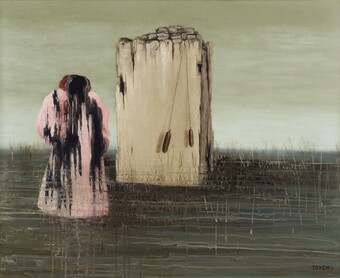
Traum (Sen), 1937
Öl auf Leinwand, 81,1 x 100 cm
Kunsthalle Praha
© Kunsthalle Praha / VG Bild-Kunst,
Bonn 2025
Diese Pressebilder stehen in druckfähiger Qualität im Online-Presseservice unter www.hamburger-kunsthalle.de zum Download bereit. Veröffentlichung nur gestattet im Zusammenhang mit einer aktuellen redaktionellen Berichterstattung über die Ausstellung in der Hamburger Kunsthalle. Jede andere Nutzung ist nicht gestattet. Die Bilder dürfen nicht angeschnitten und/oder mit Schrift überschrieben werden. Hinweis zur VG Bild-Kunst: Eine kostenfreie Veröffentlichung ist nur im Rahmen der aktuellen Berichterstattung über die Ausstellung ab 3 Monaten vor Beginn und bis 6 Wochen nach Ende der Ausstellung gestattet. Für die Verwendung in Social Media-Kanälen bedarf es einer gesonderten Klärung mit der VG Bild-Kunst.
Publication only allowed in connection with editorial reports of the exhibition. Any other use is not allowed. The photos should not be cropped or overwritten with any form of text. Note on VG Bild-Kunst: A free publication is only permitted within the scope of the reporting on the exhibition, from 3 months before the exhibition starts and until 6 weeks after the ending. For use in social media channels it requires a separate clarification with the VG Bild-Kunst.
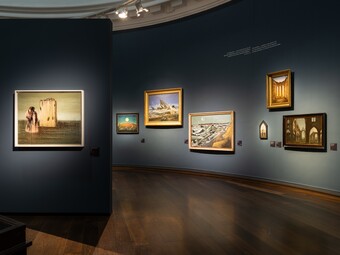
Toyen: Kunsthalle Praha © Kunsthalle Praha © VG Bild-Kunst, Bonn 2025.
Ernst: Kunsthaus Zürich © VG Bild-Kunst, Bonn 2025.
Friedrich: Hamburger Kunsthalle © Hamburger Kunsthalle / bpk.
Nash: Tate: Presented by the War Artists Advisory Committee 1946 © Tate.
1) Carus: Privatsammlung.
Friedrich: Hamburger Kunsthalle, Dauerleihgabe Privatbesitz © Privatsammlung in der Hamburger Kunsthalle.
2) Carus: Privatsammlung.
Foto: © Hamburger Kunsthalle, Fred Dott
Diese Pressebilder stehen in druckfähiger Qualität im Online-Presseservice unter www.hamburger-kunsthalle.de zum Download bereit. © Veröffentlichung nur gestattet im Zusammenhang mit einer aktuellen redaktionellen Berichterstattung über die Ausstellung in der Hamburger Kunsthalle. Jede andere Nutzung ist nicht gestattet. Die Bilder dürfen nicht angeschnitten und/oder mit Schrift überschrieben werden.
Hinweis zur VG Bild-Kunst: Eine kostenfreie Veröffentlichung ist nur im Rahmen der aktuellen Berichterstattung über die Ausstellung ab 3 Monaten vor Beginn und bis 6 Wochen nach Ende der Ausstellung gestattet. Für die Verwendung in Social Media-Kanälen bedarf es einer gesonderten Klärung mit der VG Bild-Kunst.
Publication only allowed in connection with editorial reports of the exhibition. Any other use is not allowed.
The photos should not be cropped or overwritten with any form of text.
Note on VG Bild-Kunst: A free publication is only permitted within the scope of the reporting on the exhibition, from 3 months before the exhibition starts and until 6 weeks after the ending. For use in social media channels it requires a separate clarification with the VG Bild-Kunst.
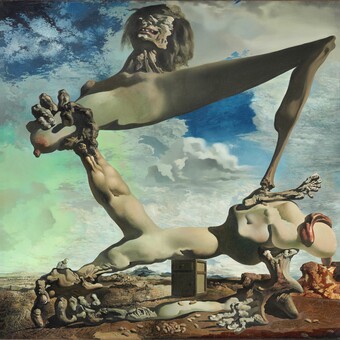
Weiche Konstruktion mit gekochten Bohnen (Vorahnung des Bürgerkriegs)
(Soft Construction with Boiled Beans (Premonition of Civil War)), 1936
Öl auf Leinwand, 99 x 100 cm
Philadelphia Museum of Art: The
Louise and Walter Arensberg Collection, 1950
© Courtesy of the Philadelphia
Museum of Art / Salvador Dali, Gala-Salvador Dali Foundation
© VG Bild-Kunst, Bonn 2025
Diese Pressebilder stehen in druckfähiger Qualität im Online-Presseservice unter www.hamburger-kunsthalle.de zum Download bereit. © Veröffentlichung nur gestattet im Zusammenhang mit einer aktuellen redaktionellen Berichterstattung über die Ausstellung in der Hamburger Kunsthalle. Jede andere Nutzung ist nicht gestattet. Die Bilder dürfen nicht angeschnitten und/oder mit Schrift überschrieben werden.
Hinweis zur VG Bild-Kunst: Eine kostenfreie Veröffentlichung ist nur im Rahmen der aktuellen Berichterstattung über die Ausstellung ab 3 Monaten vor Beginn und bis 6 Wochen nach Ende der Ausstellung gestattet. Für die Verwendung in Social Media-Kanälen bedarf es einer gesonderten Klärung mit der VG Bild-Kunst.
Publication only allowed in connection with editorial reports of the exhibition. Any other use is not allowed.
The photos should not be cropped or overwritten with any form of text.
Note on VG Bild-Kunst: A free publication is only permitted within the scope of the reporting on the exhibition, from 3 months before the exhibition starts and until 6 weeks after the ending. For use in social media channels it requires a separate clarification with the VG Bild-Kunst.
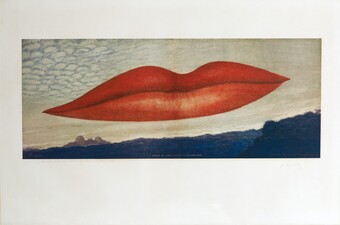
Sternwartenzeit – Die Liebenden
(À l'heure de l'observatoire – Les
Amoureux), 1970
Lithografie, 68 x 104 cm
Clo and Marcel Fleiss Collection,
Courtesy Galerie 1900–2000, Paris
© Courtesy Galerie 1900–2000, Paris
© VG Bild-Kunst, Bonn 2025
Diese Pressebilder stehen in druckfähiger Qualität im Online-Presseservice unter www.hamburger-kunsthalle.de zum Download bereit. © Veröffentlichung nur gestattet im Zusammenhang mit einer aktuellen redaktionellen Berichterstattung über die Ausstellung in der Hamburger Kunsthalle. Jede andere Nutzung ist nicht gestattet. Die Bilder dürfen nicht angeschnitten und/oder mit Schrift überschrieben werden.
Hinweis zur VG Bild-Kunst: Eine kostenfreie Veröffentlichung ist nur im Rahmen der aktuellen Berichterstattung über die Ausstellung ab 3 Monaten vor Beginn und bis 6 Wochen nach Ende der Ausstellung gestattet. Für die Verwendung in Social Media-Kanälen bedarf es einer gesonderten Klärung mit der VG Bild-Kunst.
Publication only allowed in connection with editorial reports of the exhibition. Any other use is not allowed.
The photos should not be cropped or overwritten with any form of text.
Note on VG Bild-Kunst: A free publication is only permitted within the scope of the reporting on the exhibition, from 3 months before the exhibition starts and until 6 weeks after the ending. For use in social media channels it requires a separate clarification with the VG Bild-Kunst.

Wanderer über dem Nebelmeer, um 1817
Öl auf Leinwand
94,8 x 74,8 cm
Dauerleihgabe der Stiftung Hamburger Kunstsammlungen
© SHK / Hamburger Kunsthalle / bpk Foto: Elke Walford
Diese Pressebilder stehen in druckfähiger Qualität im Online-Presseservice unter www.hamburger-kunsthalle.de zum Download bereit. Veröffentlichung nur gestattet im Zusammenhang mit einer aktuellen redaktionellen Berichterstattung über die Ausstellung in der Hamburger Kunsthalle. Jede andere Nutzung ist nicht gestattet. Die Bilder dürfen nicht angeschnitten und/oder mit Schrift überschrieben werden.
Publication only allowed in connection with editorial reports of the exhibition. Any other use is not allowed. The photos should not be cropped or overwritten with any form of text.
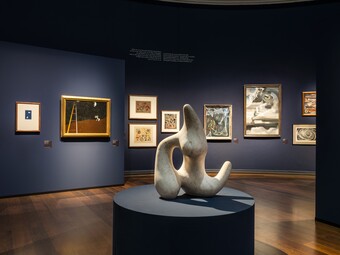
Runge: Hamburger Kunsthalle, Kupferstichkabinett © Hamburger Kunsthalle / bpk.
1) Miró: Philadelphia Museum of Art: A. E. Gallatin Collection 1952 © Courtesy of the Philadelphia Museum of Art © Successió
Miró / VG Bild-Kunst, Bonn 2025.
2) Miró: Hamburger Kunsthalle, Kupferstichkabinett © Hamburger Kunsthalle / bpk © Successió Miró / VG Bild-Kunst, Bonn 2025.
3) Miró: Hamburger Kunsthalle, Kupferstichkabinett © Hamburger Kunsthalle / bpk © Successió Miró / VG Bild-Kunst, Bonn 2025.
4) Miró: Privatsammlung, Courtesy Galerie 1900-2000, Paris © Courtesy Galerie 1900-2000, Paris © Successió Miró /
VG Bild-Kunst, Bonn 2025.
Onslow-Ford: Tate © Tate.
Domínguez: Privatsammlung © VG Bild-Kunst, Bonn 2025.
Lamba: Rowland Weinstein, Courtesy Weinstein Gallery, San Francisco © Rowland Weinstein, Courtesy Weinstein Gallery,
San Francisco © VG Bild-Kunst, Bonn 2025.
Masson: Privatsammlung © Courtesy Privatsammlung.
Arp: Hamburger Kunsthalle © Hamburger Kunsthalle / bpk © VG Bild-Kunst, Bonn 2025.
Foto: © Hamburger Kunsthalle, Fred Dott
Diese Pressebilder stehen in druckfähiger Qualität im Online-Presseservice unter www.hamburger-kunsthalle.de zum Download bereit. © Veröffentlichung nur gestattet im Zusammenhang mit einer aktuellen redaktionellen Berichterstattung über die Ausstellung in der Hamburger Kunsthalle. Jede andere Nutzung ist nicht gestattet. Die Bilder dürfen nicht angeschnitten und/oder mit Schrift überschrieben werden.
Hinweis zur VG Bild-Kunst: Eine kostenfreie Veröffentlichung ist nur im Rahmen der aktuellen Berichterstattung über die Ausstellung ab 3 Monaten vor Beginn und bis 6 Wochen nach Ende der Ausstellung gestattet. Für die Verwendung in Social Media-Kanälen bedarf es einer gesonderten Klärung mit der VG Bild-Kunst.
Publication only allowed in connection with editorial reports of the exhibition. Any other use is not allowed.
The photos should not be cropped or overwritten with any form of text.
Note on VG Bild-Kunst: A free publication is only permitted within the scope of the reporting on the exhibition, from 3 months before the exhibition starts and until 6 weeks after the ending. For use in social media channels it requires a separate clarification with the VG Bild-Kunst.
![René Magritte (1898–1967) Das doppelte Geheimnis (Le double secret), 1927 Öl auf Leinwand, 114 x 162 cm Centre Pompidou, Paris, Musée national d’art moderne / Centre de création industrielle, Ankauf 1980, © bpk / CNAC-MNAM / Georges Meguerditchian © VG Bild-Kunst, Bonn 2025 [Nur auf Anfrage erhältlich.] René Magritte (1898–1967) Das doppelte Geheimnis (Le double secret), 1927 Öl auf Leinwand, 114 x 162 cm Centre Pompidou, Paris, Musée national d’art moderne / Centre de création industrielle, Ankauf 1980, © bpk / CNAC-MNAM / Georges Meguerditchian © VG Bild-Kunst, Bonn 2025 [Nur auf Anfrage erhältlich.]](/sites/default/files/styles/340_breit/public/2025-05/Magritte_Das_doppelte_Geheimnis_1927_klein_mit_Balken.png?itok=mnMveekf)
1927 Öl auf Leinwand,
114 x 162 cm
Centre Pompidou, Paris, Musée national d’art moderne / Centre de création industrielle, Ankauf 1980,
© bpk / CNAC-MNAM / Georges Meguerditchian
© VG Bild-Kunst, Bonn 2025 [Nur auf Anfrage erhältlich.]
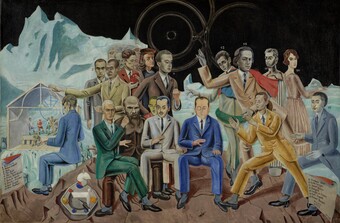
Das Rendezvous der Freunde (Au rendezvous des amis), 1922
Öl auf Leinwand, 130 x 195 cm
Museum Ludwig / Erworben mit Unterstützung des Landes Nordrhein- Westfalen 1971
© Rheinisches Bildarchiv Köln
© VG Bild-Kunst, Bonn 2025
Diese Pressebilder stehen in druckfähiger Qualität im Online-Presseservice unter www.hamburger-kunsthalle.de zum Download bereit. © Veröffentlichung nur gestattet im Zusammenhang mit einer aktuellen redaktionellen Berichterstattung über die Ausstellung in der Hamburger Kunsthalle. Jede andere Nutzung ist nicht gestattet. Die Bilder dürfen nicht angeschnitten und/oder mit Schrift überschrieben werden.
Hinweis zur VG Bild-Kunst: Eine kostenfreie Veröffentlichung ist nur im Rahmen der aktuellen Berichterstattung über die Ausstellung ab 3 Monaten vor Beginn und bis 6 Wochen nach Ende der Ausstellung gestattet. Für die Verwendung in Social Media-Kanälen bedarf es einer gesonderten Klärung mit der VG Bild-Kunst.
Publication only allowed in connection with editorial reports of the exhibition. Any other use is not allowed.
The photos should not be cropped or overwritten with any form of text.
Note on VG Bild-Kunst: A free publication is only permitted within the scope of the reporting on the exhibition, from 3 months before the exhibition starts and until 6 weeks after the ending. For use in social media channels it requires a separate clarification with the VG Bild-Kunst.
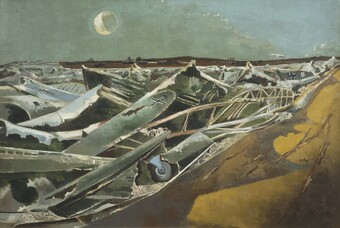
Totes Meer, 1940/41
Öl auf Leinwand, 102 x 152,4 cm
Tate: Presented by the War Artists
Advisory Committee 1946
© Tate
Diese Pressebilder stehen in druckfähiger Qualität im Online-Presseservice unter www.hamburger-kunsthalle.de zum Downloadbereit.
© Veröffentlichung nur gestattet im Zusammenhang mit einer aktuellen redaktionellen Berichterstattung über die Ausstellung in der Hamburger Kunsthalle. Jede andere Nutzung ist nicht gestattet. Die Bilder dürfen nicht angeschnitten und/oder mit Schrift überschrieben werden.
Publication only allowed in connection with editorial reports of the exhibition. Any other use is not allowed.
The photos should not be cropped or overwritten with any form of text.
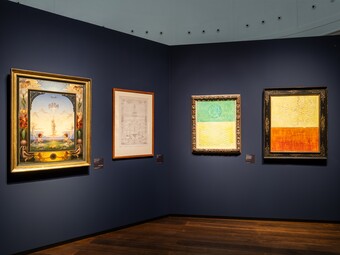
1) Runge: Hamburger Kunsthalle © Hamburger Kunsthalle / bpk.
2) Runge: Hamburger Kunsthalle, Kupferstichkabinett © Hamburger Kunsthalle / bpk.
3) Ernst: Privatsammlung © VG Bild-Kunst, Bonn 2025.
4) Ernst: Hamburger Kunsthalle © SHK / Hamburger Kunsthalle © VG Bild-Kunst, Bonn 2025.
Foto: © Hamburger Kunsthalle, Fred Dott
Diese Pressebilder stehen in druckfähiger Qualität im Online-Presseservice unter www.hamburger-kunsthalle.de zum Download bereit. © Veröffentlichung nur gestattet im Zusammenhang mit einer aktuellen redaktionellen Berichterstattung über die Ausstellung in der Hamburger Kunsthalle. Jede andere Nutzung ist nicht gestattet. Die Bilder dürfen nicht angeschnitten und/oder mit Schrift überschrieben werden.
Hinweis zur VG Bild-Kunst: Eine kostenfreie Veröffentlichung ist nur im Rahmen der aktuellen Berichterstattung über die Ausstellung ab 3 Monaten vor Beginn und bis 6 Wochen nach Ende der Ausstellung gestattet. Für die Verwendung in Social Media-Kanälen bedarf es einer gesonderten Klärung mit der VG Bild-Kunst.
Publication only allowed in connection with editorial reports of the exhibition. Any other use is not allowed.
The photos should not be cropped or overwritten with any form of text.
Note on VG Bild-Kunst: A free publication is only permitted within the scope of the reporting on the exhibition, from 3 months before the exhibition starts and until 6 weeks after the ending. For use in social media channels it requires a separate clarification with the VG Bild-Kunst.
